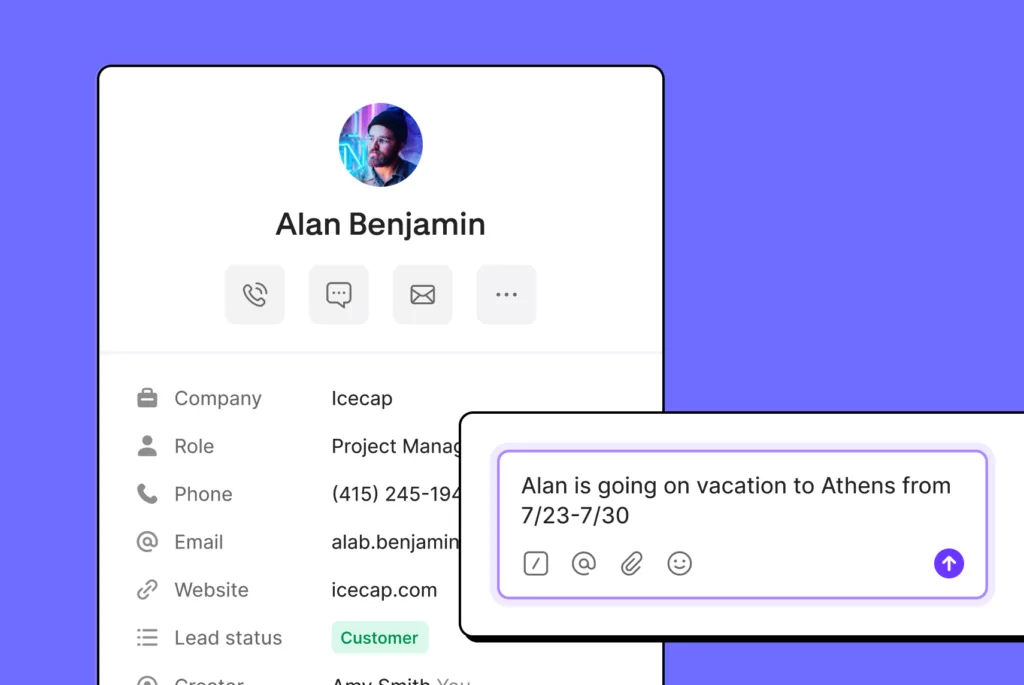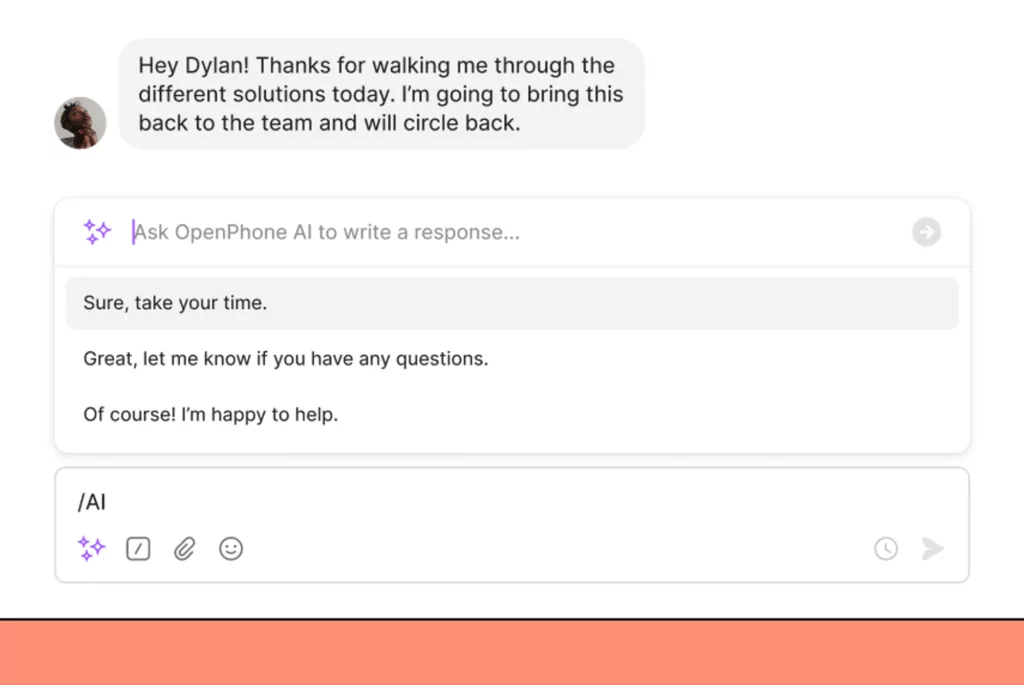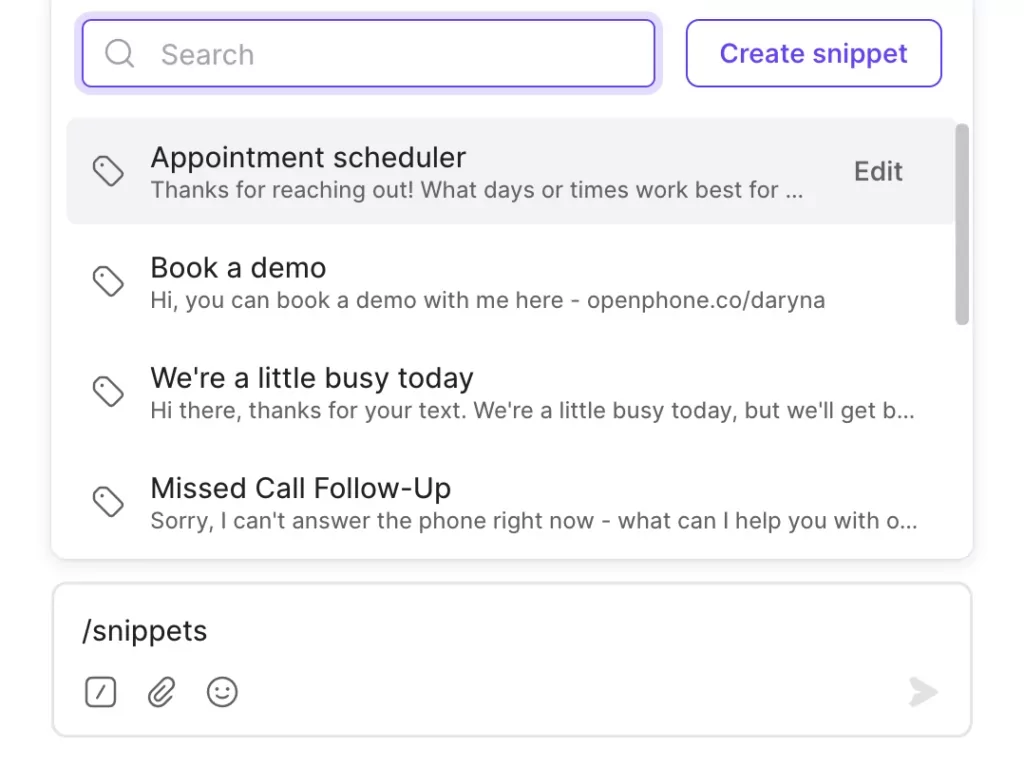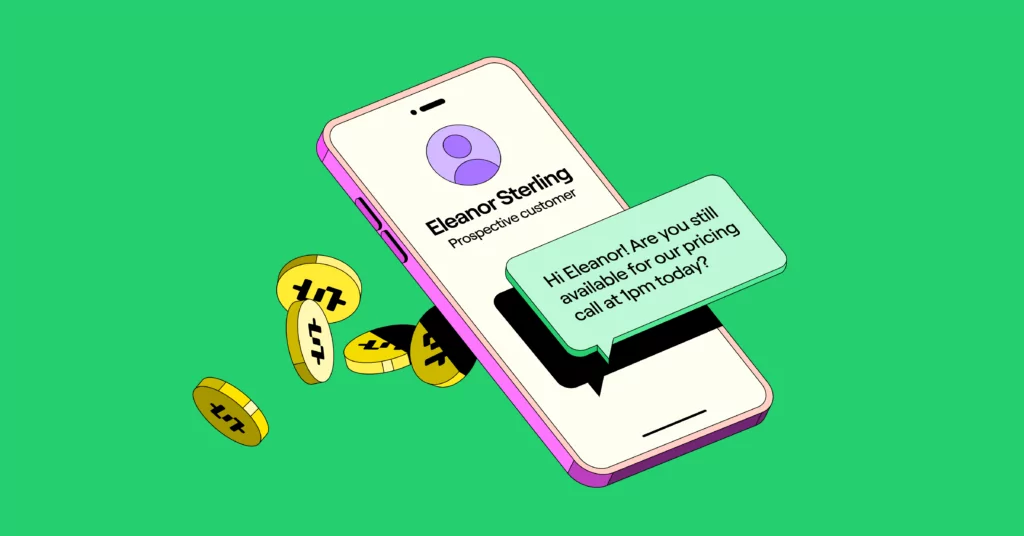Modern customers have no shortage of options in today’s market, which means regular, engaging follow-up texts can be key to keeping your company top of mind and ensuring quality leads don’t slip away.
Of course, following up isn’t about sending just any SMS messages to your sales prospects. To use business text messaging effectively, you need to know the right information, questions, and notifications to send at the right times.
In this article, we’ll provide sales text message examples you can use for driving leads through three key stages of the sales cycle:
- Discovery, when leads first interact with your brand
- Interest, when leads begin researching your products and services more intently
- Decision, when leads seriously consider a purchase
You can use each of these SMS templates to speed up your workflow, then implement our sales texting tips to maximize your response rates.
Sales text message examples for the discovery stage
When leads enter your sales funnel, they’re getting to know your brand for the first time. As soon as you get their phone number, making a good impression is all about reaching out as soon as possible. Then, you can continue creating a great customer experience by providing more information via text and deepening your prospect’s engagement with your brand.
Here are a few text message templates your sales team can use in the discovery stage of the sales process:
1. Follow-up for consultation request
Hi [Client Name]! [Your Name] from [Company Name] here. I’m happy to provide the consultation you requested. Pick any time that works for you here: [URL]. Can’t wait to chat!
2. Follow-up for quote request
Hi [Client Name]! Thanks for your interest in [Company Name]. We’d love to provide a quote. Are you free for a quick phone call to ensure an accurate estimate?
3. Phone call confirmation
Hi [Client Name], it’s [Your Name] from [Company Name]. Are you still available for our call at [Time] today?
4. Instant price estimate
Hi [Client Name]! Thanks for your interest in [Company Name]. We offer subscriptions for $[Price] per month. Text us your email to get an invite for a free trial.
5. Follow-up for no response
Hi [Client Name], thanks again for your interest in [Company Name]. Are you still interested in a consultation? Feel free to schedule a time here: [URL]
6. Webinar reminder text
Hi [Client Name], thanks for signing up for our event! The webinar starts in 30 min. We hope to see you there. Find details for joining in our calendar invite here: [URL]
7. Lead qualification text
Hi [Client Name]! Thanks for your interest in our credit card services. Are you looking for a credit card for business or personal use?
8. Follow-up after voicemail
Hi [Client Name]! [Your Name] from [Company Name] here. I left a voicemail regarding your interest in our services. Are you free to discuss pricing this week?
9. Follow-up after ebook download
Hi [Client Name], [Your Name] from [Company Name] here. I saw you downloaded our [Ebook title] ebook. Do you have any questions? I’d be happy to answer them.
Sales text message examples for the interest stage
It’s easy to commit to follow-up texts at the start of your customer relationship — when you’re both eager to learn more about each other — but continuing your momentum is essential for making sales. The average sales rep needs eight touchpoints to get the initial meeting. Many more follow-ups are typically needed to land a purchase.
These sales text message examples can keep your open deals going strong.
10. Video call request
[Hi [Client Name], hope you’ve had a great [Day of the Week]! I’d love to schedule a video call to provide a personalized product demo. Feel free to pick a time here: [URL]
11. Free trial check-in
Hi [Client Name]! How’s your free trial of [Product Name] going?
12. Client question follow-up
Hey there, [Client Name]. I checked in with my manager and we’re confident we can accommodate a team of your size. Do you have time to chat about our proposal?
13. Proposal follow-up
Hi [Client Name], I sent a proposal over to your email. Let me know if you have any questions once you review it. Thanks!
14. Lead reengagement
Hey [Client Name]! Last time we spoke, you were looking for a faster [Product]. We just launched a new product line with [Features]. Check it out: [URL]
15. Follow-up after phone call
Great speaking with you today, [Name]. Feel free to text me here if you have any further questions.
16. Relationship nurturing
Hi [Name], How was your trip to Lisbon? Were you able to check out the breakfast spot I visited?
Pro tip: Nurture relationships by adding a personal touch
When you build rapport, find common areas of interest, and connect with your clients, you increase your chances they will like talking to you. But if you’re nurturing many relationships at the same time, it can be hard to keep track of all your client’s personality traits.
One way you can keep track of this is to take notes directly in context with the conversations you have with your contacts.

A business phone like OpenPhone lets you capture client notes directly in the app. That way, the next time you speak with a client, you can see the notes you took previously and mention them on the call. It only takes a second to jot down, but asking a client how their vacation in Portugal was or how their kid’s birthday party went is an investment in their emotional piggy bank.
17. Lead reengagement – sharing wins
Hi [Client Name]! Just wanted to share that we [Achievement]. I’d love to get on a call to discuss how we can help you with [Customer Goal]. What’s your availability for this week?
18. In-person meet-up request
Hi [Client Name]! I’m in town for a couple of days for [ Reason]. Do you have time to get a coffee today or tomorrow?
How an agency owner uses SMS to engage leads
Andrew Boyd, co-founder of marketing agency Forte Analytica, uses SMS to re-engage with past clients to drum up new business from them.
One way he does this is by letting clients know that he’s available to meet with them.
“Last month, while planning a trip in the US — I’m in the UK — I contacted all our existing clients and previous clients that had gone quiet just to let them know I would be around for a coffee,” says Andrew. “It worked really well!”
After his trip, Andrew engaged with them again by sharing PR placements he had won for his current clients. While he didn’t get any responses, it eventually led to sales and return clients for his agency.
As Andrew puts it, “You basically need to make conversation with your leads to be top of mind for them, and what better way to do so than with SMS?”
Sales text message examples for the decision stage
Getting leads to complete the closing or checkout process can be as simple as nudging them toward a purchase with a sales promotion or a reminder. After the purchase is complete or deal is closed, it’s important to continue your text message marketing to ensure your new clients stick and continue providing value to your business.
These sales text message examples can help you prevent stalling and build a loyal customer base.
19. Appointment reminder
Hi [Client Name]! I’ve got you down for a [Type of] appointment on [Date] at [Time]. I’m looking forward to working with you!
Check out our guide to appointment reminder texts for more examples.
20. Payment reminder text
Hi [Client Name], I sent over an invoice last week for your requested services. The pricing guarantee expires [Date]. Pay now to lock in the price: [URL]
Check out our guide on payment reminder text messages for additional email and text templates.
21. Post-purchase thanks
Hi [Client Name], thank you so much for becoming a [Company Name] subscriber! We’re ecstatic to have you as a customer. Feel free to text us with any questions.
22. Cross-selling text
Hi [Client Name], thanks for your purchase of our [Product]. Continue [Action] with our [Other Product] to get more [Benefit]: [URL]
23. Account manager introduction
Hi [Client Name]! Thanks for choosing [Company Name]. Your account manager, [Name], will be reaching out today to get you started with our onboarding process.
24. Upselling text
Hi [Client Name], I know you’re interested in our [Pricing Plan Name] plan, but I noticed that [Reason Why Plan Might Not Work]. Our [New Pricing Plan Name] might work better for you. Can we hop on a call to discuss today or tomorrow?
Pro tip: Use SMS to handle client objections
Sales text messages aren’t just useful to nurture your open deals; they can also be used to backchannel with your customers and handle client objections in real time on calls.
Sean Mackay, account executive at JLL Technologies, uses SMS to handle client objections on demo calls.
One of his demo calls, led by his Solution Engineer, was attended by the deal’s key stakeholders, including the champion and the ultimate decision-maker.
“Once we got into the meat of it,” says Sean, “the decision maker was coming up with objections that I believed were non issues based on previous discussions with my champion and other stakeholders.”
Sean texted the champion to ask why these objections were being raised. He immediately got a reply where the champion explained why, mentioning an incident that had occurred that week that influenced the decision-maker and caused them to raise these objections.
Sean was then able to address these objections on the call directly, and by the end of the call, it led to a successful outcome for his team.
“Text was the only communication means that worked in that scenario and now I always have my phone handy just in case!” says Sean.
The difference between sales text messaging and SMS marketing
When you’re looking for sales messaging examples, it’s easy to confuse direct sales messages with SMS marketing messages. Even if you Google “sales messaging examples,” it might yield confusing answers and not differentiate. So, let’s set things straight with clear definitions and use cases.
Sales text messaging is when sales representatives — usually in the B2B space — message prospects on a 1:1 and custom basis. Sales representatives typically send sales text messages to nurture a potential lead, build a relationship, and introduce a product or service. For example, if a prospect signs up for a webinar or fills out a form asking a particular company for more information, a salesperson would send a text to strike up a sales conversation. While most sales texts are sent before a sale, sales representatives may also send a sales text message after to follow up and ask the customer how their experience with a product or service is going.
Here are some more examples of when a sales professional may send a text message:
- Send an intro after a cold call or email
- Respond to an inquiry or online form
- Touch base after meeting at a trade show or event
- Check in after sending a proposal
SMS text messaging for marketing, on the other hand, is when a business — usually consumer-based — sends bulk (but segmented) promotional messages to a list of customers who have opted-in to receive marketing messages from the company. For example, an e-commerce business may send a bulk message in November advertising their special offers for Cyber Monday.
Some additional examples of SMS marketing campaigns include:
- Exclusive offers with limited-time promo codes
- New product drops to customers who’ve opted-in
- Happy birthday messages with a coupon code they can use on their special day
Quick recap: Sales text messages come from sales personnel to help qualify potential customers and build relationships. SMS messages come from marketing teams to consumers to help drive immediate purchases. By understanding what messaging approach your business needs, you can choose the right text messaging platform.
If you’re a B2B business, you’ll want to look for a platform that not only helps you message your customers but also lets your team build 1:1 relationships with prospects. You’ll also need team collaboration features like group messaging, internal threads, snippets, and auto-replies.
If you’re a consumer-based business with a strong SMS marketing strategy, you should prioritize an SMS messaging platform with bulk texting features, SMS campaign automation, and SMS marketing compliance features.
Tips for sending effective sales texts
When you’re ready to use text messages for your sales follow-ups, you need to make sure you’re providing a great customer experience, no matter which stage of the sales cycle your clients are in. This way, you can keep your text message open rates high and your subscriber churn rates low. Here are four tips to help you send better sales texts:
- Get consent before texting. Ensure leads or customers opt in to receive texts from your team before sending the first message. You can gain consent through a digital form on your website or in person via a physical document.
- Identify yourself. Just because you spoke to someone over the phone doesn’t mean they have you saved as a contact. Introduce yourself at the beginning of your message or include a text message signature at the end.
- Personalize your texts. Texts that address your clients by name and are directly relevant to their needs are more likely to increase response rates and link clicks.
- Limit your texts. Texting can be more intrusive than channels like social media and email marketing. Avoid sending daily texts to clients to respect their boundaries.
- Keep time zones in mind. Whether you need to do a little LinkedIn sleuthing or reference your existing CRM data, avoid sending texts outside of standard business hours in your customer’s time zone for a good customer experience.
- Conclude messages with an open-ended question. Adam Bensman of The Roof Strategist shares that the point of sending a sales text message is to get a reply. To do that, end your messages with an open-ended question so that clients respond.
- Keep it short. Nobody likes a long text message, least of all from a salesperson. Keep every SMS exchange with your clients short and sweet. If you need to give a long explanation or answer a question, ask your customer whether they’re available to get on a quick call to discuss it.
- Send more messages faster with AI. Juggling a lot of clients at the same time? You might have to respond to several messages at once. Instead of struggling to craft the perfect text each time, send more messages faster with AI.
OpenPhone’s AI-suggested text responses feature analyzes the context of your conversation and suggests 2-3 relevant replies to a message. You can choose a reply option and tweak it before sending it to your client.
Want to learn more about AI-suggested text responses? Check out this article to learn more

Streamline your sales texts with OpenPhone
These sales text message examples are just 24 of the many SMS templates you can use to drive leads through the sales funnel and close more deals. As long as you’re following good sales text etiquette — like personalizing your texts and texting at appropriate hours — you can increase prospects’ interest and engagement, one message at a time.

With OpenPhone, you can easily send the right texts at the right sales stages. Use the snippets feature to save sales text message templates, which you can quickly customize and send to leads when it’s most relevant. Or, you can use the Zapier integration to automate sales texts — for example, when a contact property changes in your sales CRM.
Start a free seven-day trial of OpenPhone to explore more features of our VoIP service and reimagine your business phone system.
